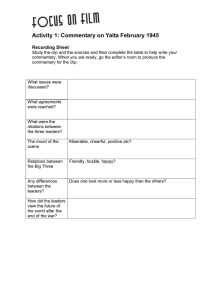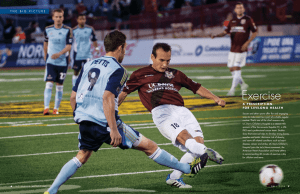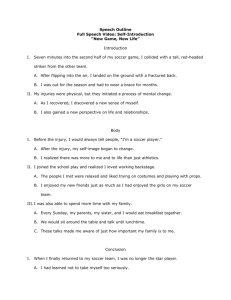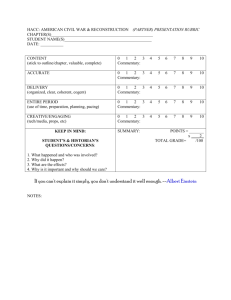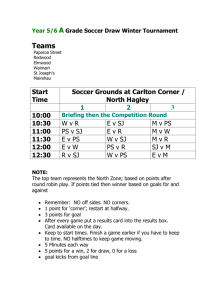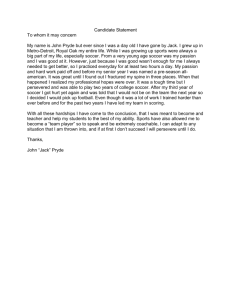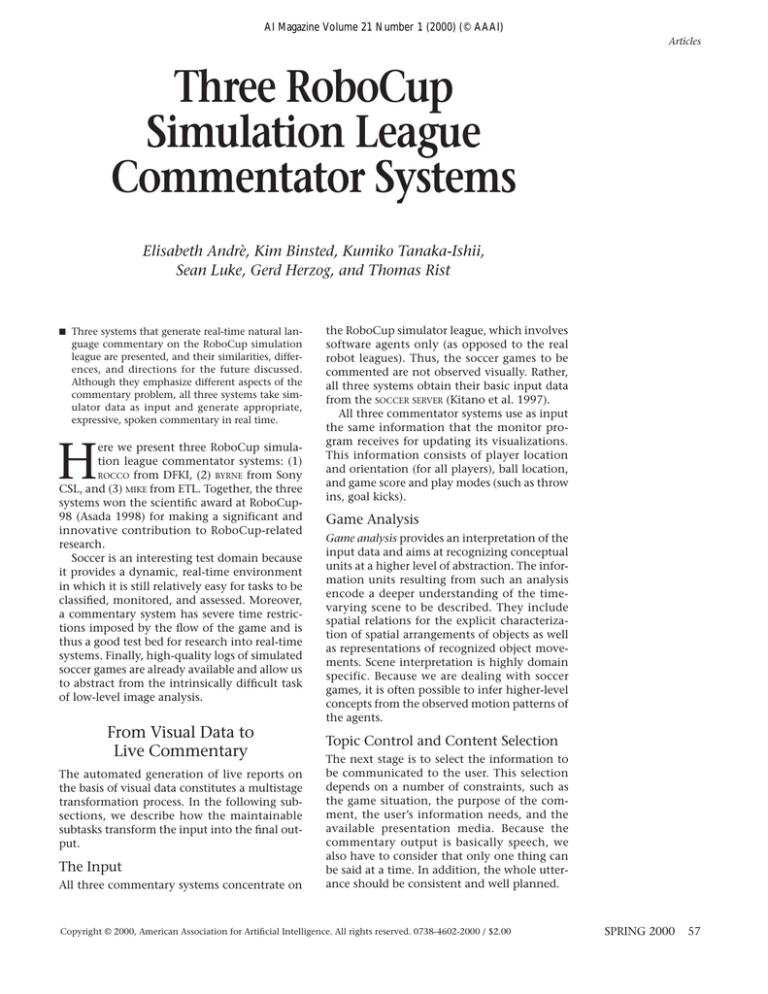
AI Magazine Volume 21 Number 1 (2000) (© AAAI)
Articles
Three RoboCup
Simulation League
Commentator Systems
Elisabeth Andrè, Kim Binsted, Kumiko Tanaka-Ishii,
Sean Luke, Gerd Herzog, and Thomas Rist
■ Three systems that generate real-time natural lan-
guage commentary on the RoboCup simulation
league are presented, and their similarities, differences, and directions for the future discussed.
Although they emphasize different aspects of the
commentary problem, all three systems take simulator data as input and generate appropriate,
expressive, spoken commentary in real time.
H
ere we present three RoboCup simulation league commentator systems: (1)
ROCCO from DFKI, (2) BYRNE from Sony
CSL, and (3) MIKE from ETL. Together, the three
systems won the scientific award at RoboCup98 (Asada 1998) for making a significant and
innovative contribution to RoboCup-related
research.
Soccer is an interesting test domain because
it provides a dynamic, real-time environment
in which it is still relatively easy for tasks to be
classified, monitored, and assessed. Moreover,
a commentary system has severe time restrictions imposed by the flow of the game and is
thus a good test bed for research into real-time
systems. Finally, high-quality logs of simulated
soccer games are already available and allow us
to abstract from the intrinsically difficult task
of low-level image analysis.
From Visual Data to
Live Commentary
The automated generation of live reports on
the basis of visual data constitutes a multistage
transformation process. In the following subsections, we describe how the maintainable
subtasks transform the input into the final output.
The Input
All three commentary systems concentrate on
the RoboCup simulator league, which involves
software agents only (as opposed to the real
robot leagues). Thus, the soccer games to be
commented are not observed visually. Rather,
all three systems obtain their basic input data
from the SOCCER SERVER (Kitano et al. 1997).
All three commentator systems use as input
the same information that the monitor program receives for updating its visualizations.
This information consists of player location
and orientation (for all players), ball location,
and game score and play modes (such as throw
ins, goal kicks).
Game Analysis
Game analysis provides an interpretation of the
input data and aims at recognizing conceptual
units at a higher level of abstraction. The information units resulting from such an analysis
encode a deeper understanding of the timevarying scene to be described. They include
spatial relations for the explicit characterization of spatial arrangements of objects as well
as representations of recognized object movements. Scene interpretation is highly domain
specific. Because we are dealing with soccer
games, it is often possible to infer higher-level
concepts from the observed motion patterns of
the agents.
Topic Control and Content Selection
The next stage is to select the information to
be communicated to the user. This selection
depends on a number of constraints, such as
the game situation, the purpose of the comment, the user’s information needs, and the
available presentation media. Because the
commentary output is basically speech, we
also have to consider that only one thing can
be said at a time. In addition, the whole utterance should be consistent and well planned.
Copyright © 2000, American Association for Artificial Intelligence. All rights reserved. 0738-4602-2000 / $2.00
SPRING 2000
57
Articles
Clients (Team A)
Soccer
2D Monitor
…
RoCCo
…
Soccer
Server
Field
Simulator
…
Clients (Team B)
Verbal
Comments
Plus
Visualization
Report Generator
Incremental
Event
Recognition
Report
Planner
Message
Board
Text Generator
Graphics Generator
Animation Generator
Upcoming
3D-Visualization
Systems
Figure 1. Connecting SOCCER SERVER and ROCCO.
Natural Language Generation
Once the content of the next utterance is decided, the text realization is performed, which
comprises grammatical encoding, linearization,
and inflection. Commentary is a real-time live
report—information must be communicated
under time pressure and in a rapidly changing
situation. The system should choose whether to
make short telegram-style utterances or grammatically complete and explanatory utterances
according to the situation. Also, it can sometimes be necessary for the commentator to
interrupt itself. For example, if an important
event (for example, a goal kick) occurs, utterances should be interrupted to communicate
the new event as soon as possible.
The Output
Finally, the natural language utterances are
piped to a speech synthesis module. To get
more natural speech output, these systems do
not rely on the default intonation of the
speech synthesizer but generate specific synthesizer instructions for expressing the corresponding emotions. These emotions, whether
hard wired into the templates or generated in
accordance with an emotional model and the
state of the game, can also be shown in the
facial expressions of an animated commentator character.
Although MIKE and ROCCO produce disem-
58
AI MAGAZINE
bodied speech, BYRNE uses a face as an additional means of communication.
ROCCO
The ROCCO commentator system is a reincarnation of an early research prototype—called SOCCER—that was built by Andrè, Herzog and Rist
(1988) in the late 1980s for the automated
interpretation and natural language description of time-varying scenes. At that time, short
sections of video recordings of soccer games
were chosen as a major application domain
because they offered interesting possibilities for
the automatic interpretation of visually observed motion patterns in a restricted domain.
Later, the work on incremental scene interpretation (Herzog and Rohr 1995; Herzog and
Wazinski 1994; Herzog et al. 1989) was combined with an approach for plan-based multimedia presentation design (Andrè et al. 1993;
Andrè and Rist 1990) to move toward the generation of various multimedia reports, such as
television-style reports and illustrated newspaper articles (Andrè, Herzog, and Rist 1994). Part
of this extension was a generic architecture for
multimedia reporting systems that describes
the representation formats and the multistage
transformation process from visual data to
multimedia reports. Both systems, the early
SOCCER as well as the new ROCCO system, can be
seen as instantiations of this architecture. In
Articles
the following discussion, we briefly sketch ROCCO ’s main components and the underlying
approaches for incremental event recognition
and report generation.
In contrast to the early SOCCER system, ROCCO
does not have to tackle the intrinsically difficult task of automatic image analysis. Instead
of using real image sequences and starting
from raw video material, it relies on the realtime game log provided by the SOCCER SERVER
(figure 1). Based on these data, ROCCO’s incremental event-recognition component performs a higher-level analysis of the scene under
consideration. The representation and automatic recognition of events is inspired by the
generic approach described in Herzog and
Wazinski (1994), which has been adopted in
ROCCO according to the practical needs of the
application context. Declarative event concepts represent a priori knowledge about typical occurrences in a scene. These event concepts are organized into an abstraction
hierarchy. Event concepts, such as locomotions
or kicks, are found at lower levels of the hierarchy because they are derived through the principle of specialization and temporal decomposition of more complex event concepts such as
a ball transfer or an attack. Simple recognition
automata, each of which corresponds to a specific concept definition, are used to recognize
events on the basis of the underlying scene
data.
The recognized occurrences, along with the
original scene data, form the input for report
generation. To meet the specific requirements
of a live report, ROCCO’s report planner relies on
an incremental discourse planning mechanism. Assuming a discrete-time model, at each
increment of a time counter, the system
decides which events have to be communicated next. Thereby, it considers the salience of
events and the time that has passed since their
occurrence. If there are no interesting events,
the system randomly selects background information from a database.
The text generator is responsible for transforming the selected information into spoken
utterances. Because it is rather tedious to specify soccer slang expressions in existing grammar formalisms, we decided to use a templatebased generator instead of fully fledged natural
language generation components, as in the earlier SOCCER system. That is, language is generated by selecting templates consisting of strings
and variables that will be instantiated with natural language references to objects delivered by
a nominal-phrase generator. To obtain a rich
repertoire of templates, 13.5 hours of television
soccer reports in English have been transcribed
and annotated. Templates are selected considering parameters such as available time, bias,
and report style. For example, short templates,
such as “Meier again,” are preferred if the system is under time pressure. Furthermore, ROCCO
maintains a discourse history to avoid repetitions and track the center of attention. For
example, a phrase such as “now Miller” should
not be uttered if Miller is the current topic. For
the synthesis of spoken utterances, ROCCO relies
on the TRUETALK (Entropic 1995) text-to-speech
software. To produce more lively reports, it
annotates the computed strings of words with
intonational markings considering the syntactic structure and the content of an utterance as
well as the speaker’s emotions. Currently, it
mainly varies pitch accent, pitch range, and
speed. For example, excitement is expressed by
a higher talking speed and pitch range.
Figure 2 shows a screen shot of the initial
JAVA-based ROCCO prototype that was taken during a typical session with the system. The monitor program provided with the RoboCup simulation environment is used to play back the
previously recorded match in the upper right
window. The text output window on the lefthand side contains a transcript of the spoken
messages that have been generated for the sample scene. ROCCO does not always generate
grammatically complete sentences but primarily produces short telegram-style utterances that
are more typical of live television reports. The
test-bed character of the ROCCO system provides
the possibility of experimenting with various
generation parameters, such as language style,
which can be set in the lower right window.
…
excitement is
expressed
by a higher
talking
speed and
pitch
range.
BYRNE
Now we present early work on an animated
talking head commentary system called BYRNE
(figure 3). This system takes the output from
the RoboCup soccer simulator and generates
appropriate affective speech and facial expressions (figure 4) based on the character’s personality, emotional state, and the state of play
(Binsted 1998).
BYRNE can use any modular game-analysis
system as its input module. For RoboCup-98,
however, BYRNE used a simple but effective playby-play game-analysis system designed for the
competition. This input module produces
remarks much faster than BYRNE is capable of
saying them. To compensate for this overabundance of things to say, the input module feeds
its remarks into a priority queue. Each remark
has a birthday (the time when it was entered
into the queue), a deadline (a time beyond
which it is “old news”), and a priority. When
SPRING 2000 59
Articles
Figure 2. The Basic Windows of the Initial ROCCO System.
BYRNE requests a new fact to say, the queue
returns a fact using a simple priority-scheduling algorithm.
The information provided by the analysis
system also drives the emotional model. The
emotion-generation module contains rules that
generate simple emotional structures. These
structures consist of a type, for example, happiness, sadness; an intensity, scored from 1 to 10;
a target (optional); a cause, that is, the fact
about the world that caused the emotion to
come into being; and a decay function, which
describes how the intensity of the emotion
decays over time.
An emotion structure–generation rule consists
of a set of preconditions, the emotional structures to be added to the emotion pool, and the
emotional structures to be removed. The preconditions are filled by matching on the currently
true facts about the world and the character.
60
AI MAGAZINE
Both emotion generation and behavior generation are influenced by the static characteristics of the commentator character. This is a set
of static facts about the character, such as its
nationality and the team it supports. It is used
to inform emotion and behavior generation,
allowing a character to react in accordance
with its preferences and biases. For example, if
a character supports the team that is winning,
its emotional state is likely to be quite different
than if it supports the losing team.
Emotion structures and static characteristics
are preconditions to the activation of high-level emotion-expressing behaviors. These, in
turn, decompose into lower-level behaviors.
The lowest-level behaviors specify how the text
output by the text-generation system is to be
marked up.
Emotionally motivated behaviors are organized in a hierarchy of mutually inconsistent
Articles
groups. If two or more activated behaviors are
inconsistent, the one with the highest activation level is performed, which usually results in
the strongest emotion being expressed. However, a behavior that is motivated by several different emotions might win out over a behavior
motivated by one strong emotion.
Emotions are expressed by adding mark up to
already-generated text. Text generation is done
simply through a set of templates. Each template has a set of preconditions that constrain
the game situations they can be used to
describe. If more than one template matches
the chosen content, then the selection is based
on how often and how recently the templates
have been used. BYRNE’s text-generation module
does not generate plain text but, rather, text
marked up with SEEML (speech, expression, and
emotion mark-up language). Linguistically
motivated facial gestures and speech intonation
are currently hard coded into the templates.
SEEML is a slightly supplemented superset of
three different mark-up systems, namely FACSML (a variant on FACS [Ekman and Friesen
1978]), SABLE (Sproat et al. 1997), and GDA
(Nagao and Hasida 1998). GDA is used to inform
linguistically motivated expressive behaviors
and also to aid the speech synthesizer in generating appropriate prosody. FACSML is used to add
facial behaviors, and SABLE is used to control the
speech synthesis.
The expression mark-up module adds emotionally motivated mark up to the already
marked-up text from the text-generation system. Conflicts are resolved in a simple (perhaps
simplistic) manner. Unless identical, tags are
assumed to be independent. If two identical
tags are assigned to a piece of text, the one with
the smaller scope is assumed to be redundant
and removed. Finally, if two otherwise identical tags call for a change in some parameter, it
is assumed that the change is additive.
The marked-up text is then sent to the SEEML
parser. The parser interprets SEEML tags in the
context of a style file, adds time markers and
lip-synching information, and sends appropriate FACS to the facial-animation system and
SABLE to the speech-synthesis system. The result
is an emotional, expressive talking-head commentary on a RoboCup simulation league soccer game.
Face
Animation
Speech
Synthesis
BYRNE
Text Markup
Text Generation
Behavior Generation
Content Selection
Emotion Generation
Game Analysis
Soccer Server
Figure 3. The BYRNE System Architecture.
Figure 4.
BYRNE Sneering.
MIKE
MIKE (multiagent interactions knowledgeably
explained) is an automatic real-time commentary system capable of producing output in
English, Japanese, and French.
One of our contributions is to demonstrate
SPRING 2000 61
Articles
TTS
(Text-To-Speech)Software
MIKE
TTS
Administrator
NL
Generator
generator
buffer
Inference
Engine
proposition
pool
Shoot
Statistic
Techniques
Bigram
shared
memory
Voronoi
Basic
Communicator
SoccerServer
Figure 5. MIKE’s Structure.
that a collection of concurrently running
analysis modules can be used to follow and
interpret the actions of multiple agents (Tanaka-Ishii et al. 1998). MIKE uses six SOCCER ANALYZER modules, three of which carry out high-level
62
AI MAGAZINE
tasks. Notably, these modules demonstrate the
general applicability of analyzing the focus of a
multiagent system and examining the territories established by individual agents.
Another technical challenge involved in live
Articles
commentary is the real-time selection of content to describe the complex, rapidly unfolding
situation (Tanaka-Ishii, Hasida, and Noda
1998). Soccer is a multiagent game in which
various events happen simultaneously in the
field. To weave a consistent and informative
commentary on such a subject, an importance
score is put on each fragment of commentary
that intuitively captures the amount of information communicated to the audience. The
inference and the content-selection modules
are both controlled by such importance scores.
From the input sent by the SOCCER SERVER,
MIKE creates a commentary that can consist of
any combination of the possible repertoire of
remarks. The commentary generation is coordinated by the architecture shown in figure 5,
where the ovals represent processes, and the
rectangles represent data. The repertoire is
shown in figure 6; an English example of MIKE’s
commentary is shown in figure 7.
There are six SOCCER ANALYZER modules, of
which three analyze basic events (shown in the
figure as the basic, techniques, and shoot
processes), and the other three carry out more
high-level analysis (shown as the bigram,
Voronoi, and statistic processes). These six
processes analyze the information posted to
the shared memory by the communicator,
communicate with each other by the shared
memory, and also post propositions to the
proposition pool.
The bigram module follows and analyzes the
ball plays as a first-order Markov chain that is a
focus point in soccer game. A 2 24 ball-play
transition matrix (22 players and 2 goals) is
automatically formed during the game and
used to describe the activity of each player and
identify successful passwork patterns. Using
this matrix, MIKE calculates and examines the
players’ ball-play performance, such as pass
success rates, winning passwork patterns, and
number of shots.
The Voronoi module calculates Voronoi diagrams for each team every 100 milliseconds.
Using these partitions, one can determine the
defensive areas covered by players and also
assess overall positioning. Figure 8 shows an
example of such a Voronoi diagram (+ and diamond indicate players of each team; box shows
the ball.).
In the future, these rich state-analysis modules will be separated from the rest of the system into a “preMIKE” module so that simulation
soccer teams or other commentary systems can
dynamically refer to the analysis results.
All interprocess communication is done by
handling an internal representation of commentary fragments, represented as proposi-
Explanation of Complex Events: This concerns form changes, position
changes, and advanced plays.
Evaluation of Team Plays: This concerns average forms, forms at a certain
moment, players’ locations, indications of the active or problematic players, winning passwork patterns, and wasteful movements.
Suggestions for Improving Play: These concern loose defense areas and better
locations for inactive players.
Predictions: These concern passes, game results, and shots at goal.
Set Pieces: These concern goal kicks, throw ins, kick offs, corner kicks, and
free kicks.
Passwork: This tracks basic ball-by-ball plays.
Figure 6. MIKE’s Commentary Repertoire.
Red3 collects the ball from Red4, Red3, Red-Team, wonderful goal! 2 to 2!
Red3’s great center shot! Equal! The Red-Team’s formation is now breaking
through enemy line from center, The Red-Team’s counter attack (Red4 near
at the center line made a long pass towards Red3 near the goal and he made
a shot very swiftly.), Red3’s goal! Kick off, Yellow-Team, Red1 is very active
because, Red1 always takes good positions, Second half of Robocup-97
quater final(Some background is described while the ball is in the mid
field.) . Left is Ohta Team, Japan, Right is Humboldt, Germany, Red1 takes
the ball, bad pass, (Yellow team’s play after kick off was interrupted by Read
team) Interception by the Yellow-Team, Wonderful dribble, Yellow2, Yellow2 (Yellow6 approaches Yellow2 for guard), Yellow6’s pass, A pass
through the opponents’ defense, Red6 can take the ball,because, Yellow6 is
being marked by Red6, .... The Red-Team’s counter attack, The Red-Team’s
formation is (system’s interruption), Yellow5, Back pass of Yellow10, Wonderful pass,
Figure 7. Example of MIKE’s Commentary.
tions. These propositions consists of a tag and
some attributes. For example, a kick by player
5 is represented as (Kick 5), where Kick is the
tag, and 5 is the attribute.
To establish the relative significance of
events, importance scores are put on propositions. After being initialized in the ANALYZER
MODULE, the score decreases over time while it
remains in the pool waiting to be uttered.
When the importance score of a proposition
reaches zero, it is deleted from the pool.
Propositions deposited in the pool are often
too low level to be directly used to generate
commentary. The INFERENCE ENGINE MODULE
processes the propositions in the pool with a
collection of over–forward-chaining inference
rules. The rules can be categorized into four
classes, based on the relation of consequences
to their antecedents: (1) logical consequences,
(2) logical subsumption, (3) second-order relations, and (4) state change. For example, (HighPassSuccessRate player) (PassPattern player
Goal) -> (active player) is a rule to make a logical consequence.
SPRING 2000 63
Articles
7
10
Figure 8. A Voronoi Diagram Example.
Analysis
Methods for
Topic Control
Ranking based
on salience,
information
gain, and age of
events
Natural Language
Generation
Parameterized
template selection
+ noun phrase
generation in real
time
Output
ROCCO
Recognition
automata
Expressive
speech
BYRNE
“Observers“
recognize events
and states
Prioritized by
birthday,
deadline, and
priority scores
Templates, marked
up for expression
and interruption in
real time
Expressive
speech and
facial
animation
MIKE
Events and states
(bigrams,
Voronoi)
Importance
scores and
inference
Templates,
interruption,
abbreviation using
importance scores
Expressive
speech
Table 1. A Comparison of the Features of the Three Commentator Systems.
Finally, the NATURAL LANGUAGE GENERATOR
selects the proposition from the proposition
pool that best fits the current state of the game
and then translates the proposition into natural language. It broadcasts the current subject to
the analyzers, so that they assign higher initial
importance values to propositions with related
subjects. Content selection is made with the
goal of maximizing the total gain of impor-
64
AI MAGAZINE
tance scores during the game. Thus, the content selection is integrated in the surface-realization module, which accounts for interruption, abbreviation, and so on.
Discussion and Future Work
Even though our focus has been on the automatic description of soccer matches, none of
Articles
the presented approaches is restricted to this
class of application. For example, the group at
DFKI originally addressed the dynamic description of traffic scenes (cf. Herzog and Wazinski
[1994]). To port our approach to the domain of
soccer, we didn’t have to change a single line in
the processing algorithms. Only our declarative knowledge sources, such as the eventrecognition automata and the natural language
templates, had to be adapted.
At Sony CSL, we are currently looking at
adapting our systems to commentate other
domains, in particular, other sports (for example, baseball, American football). Also, in real
sports commentary, commentators usually
work in pairs. One is the play-by-play commentator, and the other provides “color” (that
is, background information and statistics about
the players and teams). We are interested in
having our commentator systems mimic these
roles, taking turns providing relevant information in context.
DFKI is exploring new forms of commentary
as well. We are currently working on a threedimensional visualization component to
enable situated reports from the perspective of
a particular player.
As an application of MIKE, ETL is now developing a real-time navigation system for pedestrians, especially the blind, and also for automobiles. This system, like MIKE, senses the
position of the target to be navigated, analyzes
the situation using static information as maps,
controls topic, and then outputs the navigation as expressive speech.
Conclusions
Although there are some differences in emphasis (table 1), all three systems provide real-time,
expressive commentary on the RoboCup simulation league. All were demonstrated at
RoboCup-98, and we hope that improved versions will be shown at future RoboCup events.
The success of these systems shows that
RoboCup is not just a robot competition—it is
a challenging domain for a wide range of
research areas, including those related to realtime natural language commentary generation.
Acknowledgments
We would like to thank Dirk Voelz for his work
on the implementation of ROCCO.
References
Andrè, E., and Rist, T. 1990. Toward a Plan-Based Synthesis of Illustrated Documents. Paper presented at
the Ninth European Conference on Artificial Intelligence, 6–8 August, Stockholm, Sweden.
Andrè, E.; Herzog, G.; and Rist, T. 1994. Multimedia
Presentation of Interpreted Visual Data, Report, 103,
SFB 314–Project VITRA, Universitat des Saarlandes,
Saarbrüken, Germany.
Andrè, E.; Herzog, G.; and Rist, T. 1988. On the
Simultaneous Interpretation of Real-World Image
Sequences and Their Natural Language Description:
The System SOCCER. Paper presented at the Eighth
European Conference on Artificial Intelligence, 1–5
August, Munchen, Germany.
Andrè, E.; Finkler, W.; Graf, W.; Rist, T.; Schauder, A.;
and Wahlster, W. 1993. WIP: The Automatic Synthesis
of Multimodal Presentations. In Intelligent Multimedia Interfaces, ed. M. T. Maybury, 75–93. Menlo Park,
Calif.: AAAI Press.
Asada, M., ed. 1998. RoboCup-98: Robot Soccer
World Cup II. Paper presented at the Second
RoboCup Workshop, 2–3, 9 July, Paris, France.
Binsted, K. 1998. Character Design for Soccer Commentary. Paper presented at the Second RoboCup
Workshop, 2–3, 9 July, Paris, France.
Ekman, P., and Friesen, W. V. 1978. Manual for the
Facial-Action Coding System. Palo Alto, Calif.: Consulting Psychologists.
Entropic. TrueTalk Reference and Programmers’ Manual, Version 2.0, Entropic Research Laboratory Inc.,
Washington, D.C.
Herzog, G., and Rohr, K. 1995. Integrating Vision and
Language: Toward Automatic Description of Human
Movements. In KI-95: Advances in Artificial Intelligence. Nineteenth Annual German Conference on Artificial Intelligence, eds. I. Wachsmuth, C.-R. Rollinger,
and W. Brauer, 257–268. Berlin: Springer.
Herzog, G., and Wazinski, P. 1994. Visual Translator:
Linking Perceptions and Natural Language Descriptions. AI Review 8(2–3): 175–187.
Herzog, G.; Sung, C.-K.; Andrè, E.; Enkelmann, W.;
Nagel, H.-H.; Rist, T.; Wahlster, W.; and Zimmermann, G. 1989. Incremental Natural Language
Description of Dynamic Imagery. In Wissensbasierte
Systeme (Knowledge-Based Systems). 3. Int. GI-Kongre, 153–162. Berlin: Springer.
Kitano, H.; Asada, M.; Kuniyoshi, Y.; Noda, I.; Osawa,
E.; and Matsubara, H. 1997. RoboCup: A Challenge
Problem for AI. AI Magazine 18(1): 73–85.
Nagao, K., and Hasida, K. 1998. Automatic Text Summarization Based on the Global Document Annotation. Technical report SCSL-TR-98-021, Sony Computer Science Laboratory, Tokyo, Japan.
Sproat, R.; Taylor, P.; Tanenblatt, M.; and Isard, A.
1997. A Markup Language for Text-to-Speech Snythesis. Paper presented at EUROSPEECH’97, 22–25 September, Rhodes, Greece.
Tanaka-Ishii, K.; Hasida, K.; and Noda, I. 1998. Reactive Content Selection in the Generation of RealTime Soccer Commentary. Paper presented at COLING-98, 10–14 August, Montreal, Canada.
Tanaka-Ishii, K.; Noda, I.; Frank, I.; Nakashima, H.;
Hasida, K.; and Matsubara, H. 1998. MIKE: An Automatic Commentary System for Soccer. Paper presented at the 1998 International Conference on Multiagent Systems, 4–7 July, Paris, France.
SPRING 2000 65
Articles
Expertise in Context:
Human and Machine
Paul J. Feltovich
Kenneth M. Ford
Robert R. Hoffman
AAAI Press / The MIT Press
690 pp., $40.00., ISBN 0-262-56110-7
To order call 800-356-0343 (US and Canada) or
(617) 625-8569.
Distributed by The MIT Press,
5 Cambridge Center, Cambridge, MA 02142
Elisabeth Andrè is a
principal researcher at
the German Research
Center for Artificial
Intelligence in Saarbrüken, Germany. She is
the chair of the ACL Special Interest Group on
Multimedia Language
Processing. She is on the editorial board of
Artificial Intelligence Communications and is
the area editor for Intelligent User Interfaces of the Electronic Transactions of Artificial Intelligence. Her research interests
include multimedia communication, synthetic agents, and natural language interfaces. Her e-mail address is andre@dfki.de.
Kim Binsted (Ph.D., AI, University of Edinburgh, 1996; B.Sc., physics, McGill University, 1991) has been an associate researcher
at the Sony Computer Science Laboratories
in Tokyo, Japan, since January 1998. Her
focus is on responsive entertainment and
expressive characters. Previously, she was a
Science and Technology Agency Postdoctoral Fellow at the Kansai Advanced
Research Center (KARC-CRL) in Kobe,
where she worked on computational
humor in English and Japanese.
Gerd Herzog has been affiliated with the
Intelligent Multimedia User Interfaces Lab-
66
AI MAGAZINE
oratory at the German
Research Center for Artificial Intelligence (DFKI)
in Saarbrüken since
1996. Before joining
DFKI, he was a project
manager in the Computer Science Department at
Universit des Saarlandes,
where he was engaged in the long-term
basic research project VITRA (visual translator) of the SFB 314, a special collaborative
program on AI and knowledge-based systems, funded by the German Science Foundation. His research interests focus on
intelligent user interfaces, in particular,
vision and language integration. His e-mail
address is herzog@dfki.de.
Thomas Rist is a senior
scientist in the Department of Intelligent User
Interfaces at the German
Research Center for Artificial Intelligence, with a
research focus on adaptive multimedia systems
and multimodal interaction. He is currently a member of the European i3 (intelligent information interfaces)
Coordination Group and is in charge of
several managing tasks. His e-mail address
is rist@dfki.de.
Kumiko Tanaka-Ishii
(1991, University of
Tokyo, B.Sc., applied
mathematics; 1993, University of Tokyo, M.Sc.,
concurrent
programming; 1997, University
of Tokyo, Ph.D.) is currently a researcher at the
Electrotechnical Laboratory, Japan, where
her main research interests are natural language interface and concurrent systems.
Her e-mail address is kumiko@etl.go.jp.
Sean Luke is a research
assistant in the Department of Computer Science at the University of
Maryland. Luke received
a B.S. in computer science from Brigham
Young University and is
currently finishing his
Ph.D. at the University of Maryland. His
interests include cooperative multiagent
behavior, massively distributed knowledge
representation, robotics, and the evolution
of neural systems. His e-mail address is
seanl@cs.umd.edu.


